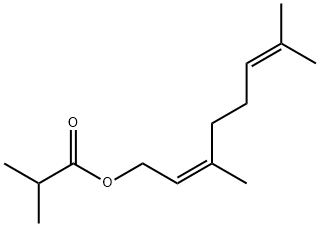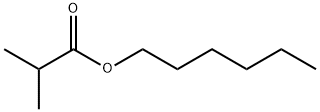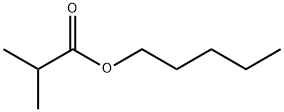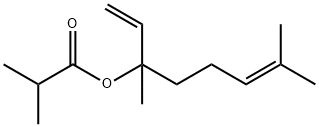OCTYL ISOBUTYRATE
- CAS NO.:109-15-9
- Empirical Formula: C12H24O2
- Molecular Weight: 200.32
- MDL number: MFCD00048933
- EINECS: 203-651-0
- SAFETY DATA SHEET (SDS)
- Update Date: 2024-12-18 14:08:52

What is OCTYL ISOBUTYRATE?
Description
Octyl isobutyrate has a fruity, fatty fragrance with a soft and humid undertone reminiscent of parsley and fern root with a sweet flavor suggestive of grape. May be prepared by esterification of n-octanol with isobutyric acid.
Chemical properties
Octyl isobutyrate has a fruity, fatty fragrance with a soft and humid undertone reminiscent of parsley and fern root. It has a sweet flavor suggestive of grape.
Occurrence
Reported found among the volatile components of hop. Also reported found in grapefruit juice and babaco fruit (Carica pentagona Heilborn).
The Uses of OCTYL ISOBUTYRATE
Octyl isobutyrate is used in imitation Pistacio, Grape, Melon, Peach, Citrus complexes, fruit blends, wine and Liqueur flavors, ect. The concentration is normally about 2 to 4 ppm in the finished product.
Preparation
Esterification of n-octanol with isobutyric acid.
Definition
ChEBI: Octyl 2-methyl-propionyl is a carboxylic ester.
Aroma threshold values
Detection: 6 ppb
Taste threshold values
Taste characteristics at 30 ppm: creamy, waxy, fruity, earthy and fatty.
Metabolism
Isobutyrates are hydrolysed to materials that are either normally in the diet or readily converted to such materials (Fassett, 1963a). Isobutyric acid occurs normally in the metabolism of valine, being converted to a propionyl group and entering into the glycogenic process (Fassett, 1963b). π-Octanol is largely oxidized in vivo; about 10% is excreted conjugated with glucuronic acid in rabbits. Isomeric octanols may be more highly conjugated; they may also be oxidized to the ketone or may be excreted unchanged (Williams, 1959).
Properties of OCTYL ISOBUTYRATE
| Melting point: | -56°C (estimate) |
| Boiling point: | 245 °C(lit.) |
| Density | 0.856 g/mL at 25 °C(lit.) |
| refractive index | n |
| FEMA | 2808 | OCTYL ISOBUTYRATE |
| Flash point: | 206 °F |
| color | A colourless liquid. |
| Odor | at 100.00 %. oily green waxy soapy clean fruity creamy |
| JECFA Number | 192 |
| EPA Substance Registry System | Propanoic acid, 2-methyl-, octyl ester (109-15-9) |
Safety information for OCTYL ISOBUTYRATE
Computed Descriptors for OCTYL ISOBUTYRATE
New Products
Tert-butyl bis(2-chloroethyl)carbamate (S)-3-Aminobutanenitrile hydrochloride N-Boc-D-alaninol N-BOC-D/L-ALANINOL N-octanoyl benzotriazole 4-Hydrazinobenzoic acid 3,4-Dibenzyloxybenzaldehyde 1,1’-CARBONYLDIIMIDAZOLE R-2-BENZYLOXY PROPIONIC ACID 1,1’-CARBONYLDI (1,2-4 TRIAZOLE) 4-HYDROXY BENZYL ALCOHOL 3-NITRO-2-METHYL ANILINE (2-Hydroxyphenyl)acetonitrile 4-Bromopyrazole 5-BROMO-2CYANO PYRIDINE 5,6-Dimethoxyindanone 5-broMo-2-chloro-N-cyclopentylpyriMidin-4-aMine 4-methoxy-3,5-dinitropyridine 2-(Cyanocyclohexyl)acetic acid 2-aminopropyl benzoate hydrochloride 1-(4-(aminomethyl)benzyl)urea hydrochloride tert-butyl 4- (ureidomethyl)benzylcarbamate diethyl 2-(2-((tertbutoxycarbonyl)amino) ethyl)malonate Ethyl-2-chloro((4-methoxyphenyl)hydrazono)acetateRelated products of tetrahydrofuran








You may like
-
 Octyl Isobutyrate CAS 109-15-9View Details
Octyl Isobutyrate CAS 109-15-9View Details
109-15-9 -
 55441-95-7 99%View Details
55441-95-7 99%View Details
55441-95-7 -
 N-Vinylformamide 99%View Details
N-Vinylformamide 99%View Details
13162-05-5 -
 Chloro Uracil 1820-81-1 99%View Details
Chloro Uracil 1820-81-1 99%View Details
1820-81-1 -
 207557-35-5 99%View Details
207557-35-5 99%View Details
207557-35-5 -
 2-ethyl-6-methyl-3-hydroxypyridine succinate 99%View Details
2-ethyl-6-methyl-3-hydroxypyridine succinate 99%View Details
127464-43-1 -
 2-ETHYLPYRIDINE 100-71-0 99%View Details
2-ETHYLPYRIDINE 100-71-0 99%View Details
100-71-0 -
 181228-33-1 (S)-Methyl 3-amino-2-((tert-butoxycarbonyl)amino)propanote Hydrochloride (DAP-OMe. HCl) 99%View Details
181228-33-1 (S)-Methyl 3-amino-2-((tert-butoxycarbonyl)amino)propanote Hydrochloride (DAP-OMe. HCl) 99%View Details
181228-33-1